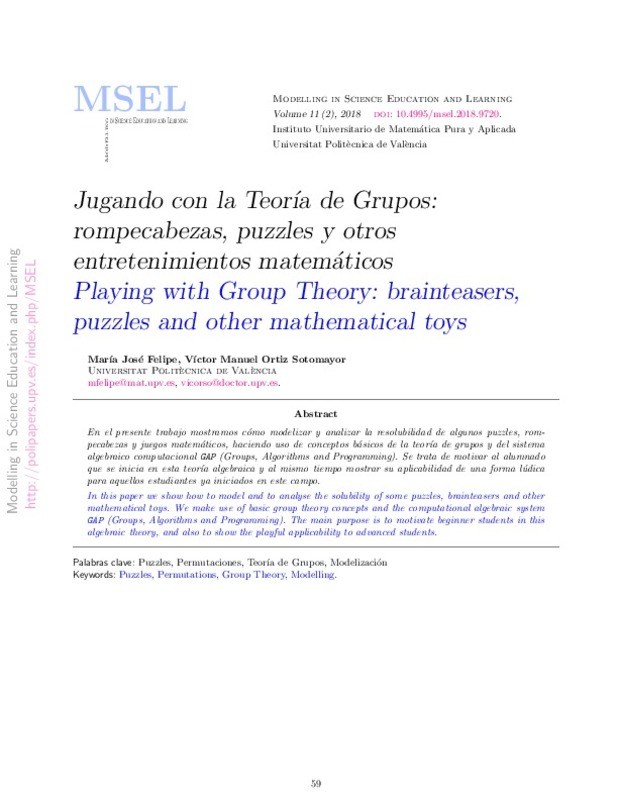JavaScript is disabled for your browser. Some features of this site may not work without it.
Buscar en RiuNet
Listar
Mi cuenta
Estadísticas
Ayuda RiuNet
Admin. UPV
Jugando con la Teoría de Grupos: rompecabezas, puzzles y otros entretenimientos matemáticos
Mostrar el registro sencillo del ítem
Ficheros en el ítem
| dc.contributor.author | Felipe, María José
|
es_ES |
| dc.contributor.author | Sotomayor, Víctor
|
es_ES |
| dc.date.accessioned | 2018-09-11T08:12:06Z | |
| dc.date.available | 2018-09-11T08:12:06Z | |
| dc.date.issued | 2018-07-31 | |
| dc.identifier.uri | http://hdl.handle.net/10251/106987 | |
| dc.description.abstract | [EN] In this paper we show how to model and to analyse the solubility of some puzzles, brainteasers and other mathematical toys. We make use of basic group theory concepts and the computational algebraic system GAP(Groups, Algorithms and Programming). The main purpose is to motivate beginner students in this algebraic theory, and also to show the playful applicability to advanced students. | es_ES |
| dc.description.abstract | [ES] En el presente trabajo mostramos cómo modelizar y analizar la resolubilidad de algunos puzzles, rompecabezas y juegos matemáticos, haciendo uso de conceptos básicos de la teoría de grupos y del sistema algebraico computacional GAP (Groups, Algorithms and Programming). Se trata de motivar al alumnado que se inicia en esta teoría algebraica y al mismo tiempo mostrar su aplicabilidad de una forma lúdica para aquellos estudiantes ya iniciados en este campo. | es_ES |
| dc.description.sponsorship | Este trabajo está financiado por el Proyecto Prometeo II/2015/011, Generalitat Valenciana (España) y por la beca predoctoral ACIF/2016/170, Generalitat Valenciana (España). Nos gustaría agradecer a LauraAvellán Carrión la creación de algunas de las fi guras presentadas y a Ana Martínez Pastor sus siempre valiosos comentarios. | es_ES |
| dc.language | Español | es_ES |
| dc.publisher | Universitat Politècnica de València | |
| dc.relation.ispartof | Modelling in Science Education and Learning | |
| dc.rights | Reconocimiento - No comercial (by-nc) | es_ES |
| dc.subject | Puzzles | es_ES |
| dc.subject | Permutaciones | es_ES |
| dc.subject | Teoría de Grupos | es_ES |
| dc.subject | Modelización | es_ES |
| dc.subject | Permutations | es_ES |
| dc.subject | Group Theory | es_ES |
| dc.subject | Modelling | es_ES |
| dc.title | Jugando con la Teoría de Grupos: rompecabezas, puzzles y otros entretenimientos matemáticos | es_ES |
| dc.title.alternative | Playing with Group Theory: brainteasers,puzzles and other mathematical toys | es_ES |
| dc.type | Artículo | es_ES |
| dc.date.updated | 2018-09-10T12:25:20Z | |
| dc.identifier.doi | 10.4995/msel.2018.9720 | |
| dc.relation.projectID | info:eu-repo/grantAgreement/GVA//PROMETEOII%2F2015%2F011/ES/Caracteres y clases de conjugación de grupos finitos II/ | es_ES |
| dc.rights.accessRights | Abierto | es_ES |
| dc.contributor.affiliation | Universitat Politècnica de València. Escola Tècnica Superior d'Enginyeria Informàtica | es_ES |
| dc.contributor.affiliation | Universitat Politècnica de València. Escuela Técnica Superior de Ingenieros Industriales - Escola Tècnica Superior d'Enginyers Industrials | es_ES |
| dc.contributor.affiliation | Universitat Politècnica de València. Instituto Universitario de Matemática Pura y Aplicada - Institut Universitari de Matemàtica Pura i Aplicada | es_ES |
| dc.contributor.affiliation | Universitat Politècnica de València. Departamento de Matemática Aplicada - Departament de Matemàtica Aplicada | es_ES |
| dc.description.bibliographicCitation | Felipe, MJ.; Sotomayor, V. (2018). Jugando con la Teoría de Grupos: rompecabezas, puzzles y otros entretenimientos matemáticos. Modelling in Science Education and Learning. 11(2):59-81. https://doi.org/10.4995/msel.2018.9720 | es_ES |
| dc.description.accrualMethod | SWORD | es_ES |
| dc.relation.publisherversion | https://doi.org/10.4995/msel.2018.9720 | es_ES |
| dc.description.upvformatpinicio | 59 | es_ES |
| dc.description.upvformatpfin | 81 | es_ES |
| dc.type.version | info:eu-repo/semantics/publishedVersion | es_ES |
| dc.description.volume | 11 | |
| dc.description.issue | 2 | |
| dc.identifier.eissn | 1988-3145 | |
| dc.contributor.funder | Generalitat Valenciana | es_ES |
| dc.description.references | Beeler, R. A.: The Fifteen Puzzle: a motivating example for the alternating group, http://faculty.etsu.edu/beelerr/fifteen-supp.pdf | es_ES |
| dc.description.references | Conrad, K.: The 15-puzzle (and Rubik's cube), http://www.math.uconn.edu/~kconrad/blurbs/grouptheory/15puzzle.pdf | es_ES |
| dc.description.references | Esteban Romero, R.: Las matemáticas del cubo de Rubik, Pensamiento Matemático 3(2): 97{110 (2013). | es_ES |
| dc.description.references | Hungerford, T. W.: Algebra, Springer-Verlag, New York (1974). | es_ES |
| dc.description.references | Joyner, D.: Adventures in group theory: Rubik's cube, Merlin's machine, and other mathematical toys, The Johns Hopkins University Press, Baltimore (2008). | es_ES |
| dc.description.references | Kaufmann, S.: A mathematical analysis of the generalized Oval Track Puzzle, Rose-Hulman Undergraduate Mathematics Journal 12(1): article 5 (2011). | es_ES |
| dc.description.references | Long, C.: Solving the TopSpin Puzzle using GAP, http://angrystatistician.blogspot.com.es/2013/07/solving-topspin-puzzle-using-gap.html | es_ES |
| dc.description.references | Mulholland, J.: Permutation Puzzles: A Mathematical Perspective, Lecture notes, http://www.sfu.ca/~jtmulhol/math302/notes/302notes.pdf | es_ES |
| dc.description.references | Sangroniz, J.: ¿Se puede hacer un huevo frito en el cubo de Rubik?, La Gaceta de la RSME 18(1): 103{120 (2015). | es_ES |
| dc.description.references | Scherphuis, J.: https://www.jaapsch.net/puzzles. | es_ES |
| dc.description.references | The Fifteen Puzzle - The Algorithm, https://rosettacode.org/wiki/15_Puzzle_Game. | es_ES |
| dc.description.references | The GAP Group, GAP - Groups, Algorithms, and Programming, Versión 4.8.5 (2016), http://www.gap-system.org. | es_ES |
| dc.description.references | The Panama Canal Puzzle, | es_ES |
| dc.description.references | http://www.cs.brandeis.edu/~storer/JimPuzzles/SLIDE/PanamaCanal/PanamaCanal.pdf. | es_ES |








